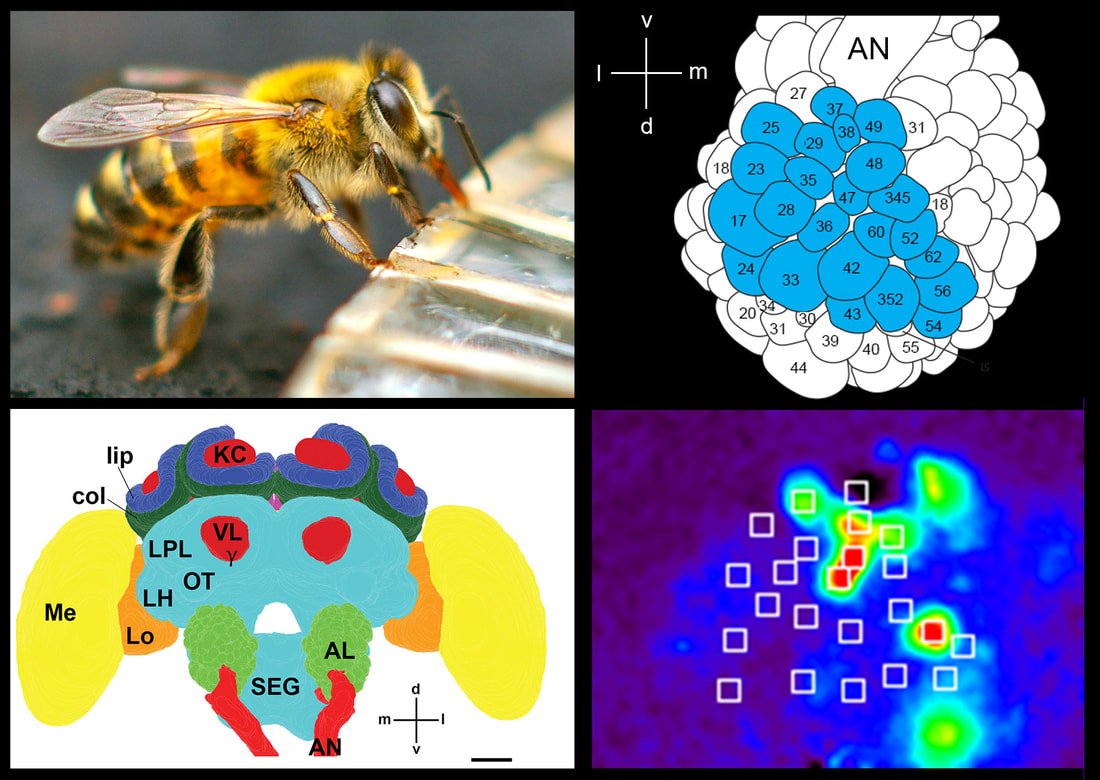|
|
|
My work ultimately seeks to understand how animals perceive and process complex social stimuli in the central brain and the mechanisms that give rise to these circuits’ development. Currently my work focuses on a special paper wasp, Polistes fuscatus, whose females posses individually distinctive color patches on their face which they use to discriminate among each other on the nest. I have identified a brain region and a physiological cell type that likely plays a role in this ability and am currently working to better characterize this system, the neural circuits involved, and what is different in young and socially naive animals. My future work will continue to look at how these circuits develop and how experience or lack-there-of shapes the tuning properties of this neural population I have discovered. Ultimately this work will allow me to test ideas about fundamental principles guiding specialized visual and social recognition circuits by comparing the circuit organization in this special wasp to the known visual circuits features in invertebrate and vertebrate systems. Additionally, this work will allow for further exploration and circuit decoding of visual object processing in the insect protocerebrum and higher-order processing in the insect brain, which largely remains a black box. Face cells in primates have allowed for a decoding of mammalian visual cortex, due to the highly specific nature of these circuits. I hope to leverage the unique features of Polistes fuscatus and other wasps to decode the insect visual central brain in a similar manner. There is a lot to do and I am excited to be at the forefront of this work as I train the next generation of insect neuroscientists!
Vision & Social processing in paper wasps
|
Multichannel electrophysiology (play with sound)
|
Paper wasps use a range of visual signals to communicate identity or fighting ability. I primarily study the vision and neural correlates of individual face recognition in female Northern paper wasps, Polistes fuscatus. Using an isolation treatment that prevents the development of facial recognition in this species colleagues and I have identified a candidate brain region involved with this unique ability, the Anterior optic tubercle (AOT). The AOT is a visual glomerulus in the insect protocerebrum that in other insects is known be involved in color processing, object-background discrimination, and female-female aggression. All aspects we would expect for a candidate 'face' processing region. This is further supported by our recent finding that color is required for specialized face recognition in this species! I am currently working hard to characterize visual processing in this system. I have recently identified face cell-like responses in these special wasps, I call wasp cells. These cells show specific selectivity for frontal views of wasps and are relatively unresponsive to other visual stimuli. They are localized to the lateral protocerebrum, near the AOT. Additionally these cells seem to show tuning to a particular axis of wasp 'face space', similar to the tuning properties of neurons in face patches of primates.
|
Olfactory plasticity in honey beesWe know a great deal about olfaction in honey bees and how honey bees process and learn odors. My research focuses on how complex, multi-component odors are processed both behaviorally and in the nervous system of bees. One of my main findings is that much of the inter-individual variation in how the nervous system - the antennal lobe - responds to odors is driven by the unique odor experiences of each bee. I also found that diverse odor experience is necessary for complex odor analysis by bees!
|
Complex Signal Integration and Object Processing
|
|
From the very beginning I have been very interested in how sensory information is integrated across modalities to form percepts of objects. My first publication identified color-dependent learning in honey bees, finding that bees cannot seem to learn UV/Violet when it is associated with sucrose as a pure color. This finding has since been replicated in unrestrained setting by colleagues in multiple lab groups. This is puzzling because bees certainly can learn to forage at violet flowers! There is an obvious missing gap from my study looking at pure color learning versus the complex array of signals presented by a flower. I hope to be able to explore these ideas by studying how more and more complex signals and objects are processed by the insect brain. In the immediate future my future work will seek to understand how objects are processed in the central brain to give rise to the neural percepts of "wasp" "familiar", "novel", "nestmate", "dominant", etc.
|
Other Projects
|
|
As a neuroethologist the nature of my work is highly integrative and therefore highly collaborative. I have developed many collaborative projects with colleagues from computer scientists to virologists and everything in between. To name a few, I've worked on developing software for tracking bees and tracking antennae. I've developed stimuli for identifying what stimuli bees are using to identify the threat of giant asian hornets. I'm also working on projects to develop tools to get cell-specific neural indicators into the nervous system of social insects!
|
